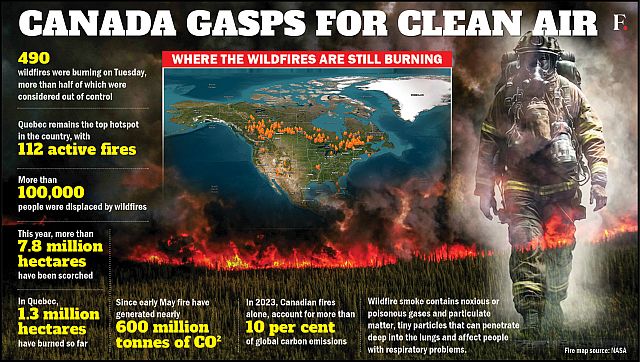Canada is facing its most devastating wildfire season on record with hundreds of blazes raging across the nation. The country with nine per cent of the world’s forests is engulfed in massive plumes of smoke, and the season has yet to reach its peak. Wildfires are common during this time of year when warmer, dry weather creates the perfect environment for blazes, especially in Canada’s forests. With the season extending from May to October each year, the devastation seen from the outset this year has put the country on track for its worst season in more than 30 years. Out-of-control fires have erupted in almost every part of Canada, forcing hundreds of people to flee. **Also Read: Canada wildfire smoke could linger over US for days: How deadly is it?** No province has been spared, not even Quebec and Nova Scotia in the east, which don’t normally see large blazes. Let’s take a closer look at what numbers tell about Canada’s worst wildfire season ever.
Close to 500 active fires A total of 490 wildfires were burning on Tuesday, more than half of which were considered out of control. These started in Western Canada in early May, prompting a state of emergency in Alberta and evacuations of tens of thousands of people. A few weeks later, as rains brought some relief to Western Canada, firefighting efforts shifted to Nova Scotia on the Atlantic Coast and Quebec, unaccustomed to the massive scale and strength of this year’s blazes. [caption id=“attachment_12803162” align=“alignnone” width=“640”] Haze from Canadian wildfires blankets the downtown Pittsburgh skyline as seen from Elliott. AP[/caption] As of Wednesday, a majority of Canada’s active fires were still classified as “out of control,” with 253 blazes in that category. Of the remaining wildfires being monitored, 153 were considered “under control” and another 77 were “being held,” which is the label assigned when a fire is not under control but also is not moving, CBC News reported. Quebec remains the top hotspot in the country, with 112 active fires, and the smoke spreading as far as the United States and Europe. [caption id=“attachment_12803412” align=“alignnone” width=“640”]
 Graphic: Pranay Bhardwaj[/caption] British Columbia, along Canada’s west coast, had the second-highest number of active blazes — 94, which was down from 99 the previous day — followed by Alberta and Ontario. In total, more than 100,000 people were displaced by wildfires across Canada. 7.8 million hectares burned In a typical year, about 7,500 wildfires burn more than 2.5 million hectares of forests in Canada. So far this year, more than 7.8 million hectares (19 million acres) — an area almost as big as Austria — have been scorched. That number, reported on Wednesday, had jumped 100,000 hectares, or nearly 250,000 acres, in just 24 hours. In Quebec, 1.3 million hectares have burned so far, compared to an average of less than 10,000 annually over the past decade.
Graphic: Pranay Bhardwaj[/caption] British Columbia, along Canada’s west coast, had the second-highest number of active blazes — 94, which was down from 99 the previous day — followed by Alberta and Ontario. In total, more than 100,000 people were displaced by wildfires across Canada. 7.8 million hectares burned In a typical year, about 7,500 wildfires burn more than 2.5 million hectares of forests in Canada. So far this year, more than 7.8 million hectares (19 million acres) — an area almost as big as Austria — have been scorched. That number, reported on Wednesday, had jumped 100,000 hectares, or nearly 250,000 acres, in just 24 hours. In Quebec, 1.3 million hectares have burned so far, compared to an average of less than 10,000 annually over the past decade.
The area burned in the last 25 days exceeded the combined total over the past 20 years.
High carbon emissions Carbon emissions released by the wildfires have already exceeded the Canadian annual record, according to the European observatory Copernicus. Since early May they have generated nearly 600 million tons of CO2, equivalent to 88 per cent of the country’s total greenhouse gas emissions from all sources in 2021, it reported. [caption id=“attachment_12803132” align=“alignnone” width=“640”] A person rides a bicycle along the shore of Lake Michigan as the downtown skyline is blanketed in haze from Canadian wildfires in Chicago. AP[/caption] Canadian fires alone in 2023 now account for more than 10 per cent of global carbon emissions from forest fires in 2022 (1,455 megatons). US states affected Wildfire smoke from eastern Canadian provinces brought a distinct spell of haze, fumes, and copper skies to the northeastern United States earlier this month. States being affected most severely this week are in the Midwest, with air quality in Chicago and Minneapolis ranked as the world’s worst and second-worst on Tuesday, according to the Swiss air quality technology company IQAir. On Wednesday, Detroit, Chicago, and Minneapolis were ranked second, third, and fourth in IQAir’s global rankings, respectively, with Toronto ranking sixth, according to CBS News. Meanwhile, NASA released an image on Tuesday showing a dense band of smoke from wildfires in eastern Canada drifting across the Atlantic Ocean and reaching as far as Europe. With inputs from AFP Read all the Latest News , Trending News , Cricket News , Bollywood News , India News and Entertainment News here. Follow us on
Facebook,
Twitter and
Instagram.


)

)
)
)
)
)
)
)
)



